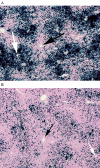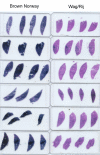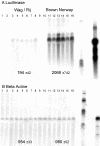Genetic heterogeneity in response to adenovirus gene therapy
- PMID: 12697054
- PMCID: PMC155537
- DOI: 10.1186/1471-2199-4-4
Genetic heterogeneity in response to adenovirus gene therapy
Abstract
Background: After intravenous delivery of the adenoviral vector into rats or mice, 95-99% of the encoded protein is produced in the hepatocytes. We observed, as have others, that the early expression levels of the vector encoded protein vary, greatly, within a species, from one animal strain to another. This study was initiated to determine the molecular mechanism causing the difference: hepatic transfection, transcription or translation. For this purpose different doses of Ad5 luciferase and Ad5 LacZ were intravenously injected into Brown Norway rats and Wag/Rij rats, two strains that differ by a factor of 10 in encoded protein levels. The proportion of LacZ positive hepatocytes, the adenoviral DNA, specific transgenic RNA and luciferase protein were compared in the two strains.
Results: The number of transduced hepatocytes and the amounts of Ad5 DNA in the livers was similar in both strains, whereas the Brown Norway rats produced 8 to 10 times more of both vector encoded proteins and of transgene mRNA than the Wag/Rij rats.
Conclusions: It is concluded that the difference between strains in vector encoded protein expression is due to different transcriptional events. No evidence was obtained to suggest that the differences are related to liver damage influenced by vector toxicity or immune reactions.
Figures







Similar articles
-
Pharmacogenetic heterogeneity of transgene expression in muscle and tumours.BMC Pharmacol. 2003 Aug 28;3:11. doi: 10.1186/1471-2210-3-11. Epub 2003 Aug 28. BMC Pharmacol. 2003. PMID: 12943556 Free PMC article.
-
Liver-directed gene transfer in non-human primates.Hum Gene Ther. 1997 Jul 1;8(10):1195-206. doi: 10.1089/hum.1997.8.10-1195. Hum Gene Ther. 1997. PMID: 9215737
-
Evaluation of the biodistribution, persistence, toxicity, and potential of germ-line transmission of a replication-competent human adenovirus following intraprostatic administration in the mouse.Mol Ther. 2000 Mar;1(3):263-74. doi: 10.1006/mthe.2000.0037. Mol Ther. 2000. PMID: 10933942
-
Adenovirus vectors containing chimeric type 5 and type 35 fiber proteins exhibit altered and expanded tropism and increase the size limit of foreign genes.Gene. 2002 Feb 20;285(1-2):69-77. doi: 10.1016/s0378-1119(02)00410-9. Gene. 2002. PMID: 12039033
-
Adenovirus de-targeting from the liver.Curr Opin Mol Ther. 2009 Oct;11(5):523-31. Curr Opin Mol Ther. 2009. PMID: 19806500 Review.
Cited by
-
Genetic heterogeneity and efficiency of two different methods of adenovirus-mediated gene transfer in a rat liver transplantation model.Surg Today. 2006;36(4):367-75. doi: 10.1007/s00595-005-3168-3. Surg Today. 2006. PMID: 16554995
-
Pharmacogenetic heterogeneity of transgene expression in muscle and tumours.BMC Pharmacol. 2003 Aug 28;3:11. doi: 10.1186/1471-2210-3-11. Epub 2003 Aug 28. BMC Pharmacol. 2003. PMID: 12943556 Free PMC article.
-
In vivo fluorescence imaging is well-suited for the monitoring of adenovirus directed transgene expression in living organisms.Mol Imaging Biol. 2010 Jun;12(3):278-85. doi: 10.1007/s11307-009-0260-x. Epub 2009 Sep 30. Mol Imaging Biol. 2010. PMID: 19789926
-
Liver Glucokinase(A456V) Induces Potent Hypoglycemia without Dyslipidemia through a Paradoxical Induction of the Catalytic Subunit of Glucose-6-Phosphatase.Int J Endocrinol. 2011;2011:707928. doi: 10.1155/2011/707928. Epub 2011 Dec 13. Int J Endocrinol. 2011. PMID: 22194744 Free PMC article.
References
-
- Wen XY, Bai Y, Stewart AK. Adenovirus-mediated human endostatin gene delivery demonstrates strain- specific antitumor activity and acute dose-dependent toxicity in mice. Hum Gene Ther. 2001;12:347–358. - PubMed
-
- Barr D, Tubb J, Ferguson D, Scaria A, Lieber A, Wilson C, Perkins J, Kay MA. Strain related variations in adenovirally mediated transgene expression from mouse hepatocytes in vivo: comparisons between immunocompetent and immunodeficient inbred strains. Gene Ther. 1995;2:151–155. - PubMed
MeSH terms
Substances
LinkOut - more resources
Full Text Sources
Medical

